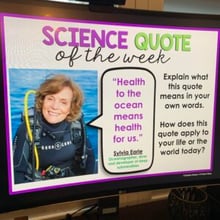Convection Currents Activities for Middle School Science
The resources below will provide students a comprehensive understanding of convection currents. All of the following lessons are also included in the Kesler Science Membership.
The Convection Currents 5E Lesson includes materials for every "E" phase, including the Convection Currents Station Lab for Exploration and an interactive PowerPoint with digital INB templates for Explanation.
The lesson also includes introduction materials for Engagement, student-choice project ideas for Elaboration, and assessments for Evaluation.
After completing the Convection Currents 5E Lesson, students will be able to recognize that the Sun provides the energy that drives convection within the atmosphere and oceans, producing winds and ocean currents.
The Convection Currents Inquiry Lab is a hands-on activity that is differentiated for advanced, on-level, and modified middle school students.
Students will investigate the rate at which radiation heats up solids versus liquids and how warm air masses rise due to convection.
The Convection Currents Inquiry Lab includes a brief reading passage, comprehension checks, hands-on activities, reflection questions, and a CER conclusion.
Convection Currents Classroom Experiences
Create a powerful student experience to help solidify students' understanding about convection currents. The following experience is also included in the Kesler Science Membership.STEM CHALLENGES
The Project, Bring on the Sun - Build a Soda Can Solar Heater STEM Challenge uses the engineering design process to design and construct a soda can solar panel that can heat a small room on a sunny day. Students will use their knowledge of thermal energy and convection currents to construct the winning design.
Students will be using collaborative skills such as brainstorming with their peers and reflecting on their progress during the project.
At the end of the Project, Bring on the Sun - Build a Soda Can Solar Heater STEM Challenge, students are given an opportunity to share their projects outside of the classroom.
Year-Round Resources
These year-round activities will increase your students' understanding of many middle school science topics. All of these activities are also included in the Kesler Science Membership.
Visual Data & Graphing
You're not alone if your students struggle with understanding graphs, charts, and tables. It's a skill that takes an enormous amount of practice. This resource will help students build a strong foundation in analyzing data and creating their own data visualizations.
Bell Ringers and Warm-Ups
These middle school science bell ringers are an excellent way to engage your students as soon as they walk into your classroom. This comprehensive FULL YEAR resource includes everything you need to start off each science class with an interesting warm-up activity.
Review Board Games
Each game board has been carefully designed to keep students engaged. There are 10 different action spaces on each board and dozens of question cards. All of the actions are related to science concepts and keep the students motivated throughout the game.
Each game is ready to play. Simply print out the board and the cards and let the students enjoy reviewing nine different units.
Essential Questions and Standards
Below are the essential questions and standards associated with the lessons and activities included in the convection currents unit. This topic is only one of more than 100 middle school science topics included in the Kesler Science Membership.
-
How does the Sun's energy drive convection within the atmosphere and oceans, producing winds and ocean currents?
-
MS ESS2-4 - Develop a model to describe the cycling of water through Earth’s systems driven by energy from the sun and the force of gravity
-
MS ESS2-6 - Develop and use a model to describe how unequal heating and rotation of the Earth cause patterns of atmospheric and oceanic circulation that determine regional climates
-
TEKS Science 8.10 A - Recognize that the Sun provides the energy that drives convection within the atmosphere and oceans, producing winds
Kesler Science Membership
Imagine never having to search for another middle school science lesson again. The membership gives you access to ALL of the Kesler Science products in one place (Yes, including everything above).
Say goodbye to long hours of lesson prep.


